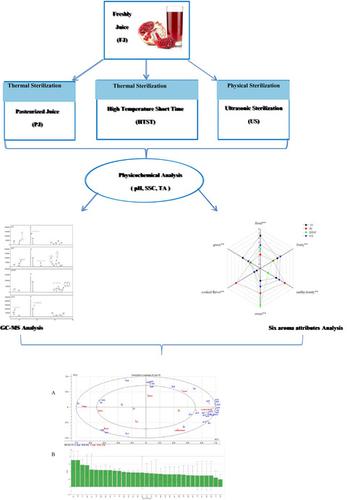当前位置:
X-MOL 学术
›
Flavour Frag. J.
›
论文详情
Our official English website, www.x-mol.net, welcomes your feedback! (Note: you will need to create a separate account there.)
Effects of sterilization methods on pomegranate juice evaluated by descriptive sensory analysis and gas chromatography‐mass spectrometry through partial least‐squares regression
Flavour and Fragrance Journal ( IF 2.6 ) Pub Date : 2020-07-25 , DOI: 10.1002/ffj.3606 Honglei Tian 1 , Cong Lu 1 , Ping Zhan 1 , Peng Wang 1 , Yu Zhao 1 , Peng Tian 1
Flavour and Fragrance Journal ( IF 2.6 ) Pub Date : 2020-07-25 , DOI: 10.1002/ffj.3606 Honglei Tian 1 , Cong Lu 1 , Ping Zhan 1 , Peng Wang 1 , Yu Zhao 1 , Peng Tian 1
Affiliation

|
This study aimed to investigate the effects of different sterilization methods on the flavor characteristics and volatile compounds of pomegranate (PG) juice. We analyzed three PG samples, namely conventional‐pasteurized, high‐temperature short‐time‐treated, and ultrasonic‐sterilized (US) juice samples. Fresh‐pressed PG (FJ) sample was used as the control. A total of 33 volatile compounds and six sensory attributes (floral, fruity, earthy/musty, sweet, green, and cooked flavor) of PG samples were analyzed by gas chromatography‐mass spectrometry and quantitative descriptive sensory analysis. Results revealed differences in the samples’ sensory profiles. Compared with thermal‐sterilization methods, the low temperature and relatively mild sterilization conditions of US considerably preserved the amount of volatile compounds. Partial least‐squares regression (PLSR) was performed to identify the relationships among sensory attributes, volatile compounds, and sterilization methods. Results showed that limonene, linalool, hexanal, and 6‐methyl‐5‐hepten‐2‐one contributed greatly to the key aroma of FJ and US. Meanwhile, p‐Cymene, (E)‐2‐nonenal, naphthalene, and benzothiazole were significantly correlated with the cooked flavor after thermal sterilization. PLSR further confirmed that compared with thermal‐sterilization methods, US may be more beneficial in preserving the volatile compound amount and sensory profiles of PG juice.
中文翻译:

描述性感官分析和气相色谱-质谱法通过偏最小二乘回归评估灭菌方法对石榴汁的影响
这项研究旨在研究不同灭菌方法对石榴(PG)汁的风味特征和挥发性化合物的影响。我们分析了三种PG样品,即常规巴氏灭菌,高温短时处理和超声灭菌(US)果汁样品。新鲜压制的PG(FJ)样品用作对照。通过气相色谱-质谱法和定量描述性感官分析法分析了PG样品中的33种挥发性化合物和6种感官属性(花香,果味,土质/麝香,甜味,绿色和煮熟的风味)。结果表明样品的感官特征存在差异。与热灭菌方法相比,美国的低温和相对温和的灭菌条件大大保留了挥发性化合物的量。进行偏最小二乘回归(PLSR)来确定感官属性,挥发性化合物和灭菌方法之间的关系。结果表明,柠檬烯,芳樟醇,己醛和6-甲基-5庚烯-2-酮对FJ和US的主要香气有很大贡献。同时,对-Cymene,(E)-2-壬烯醛,萘和苯并噻唑与热灭菌后的熟味显着相关。PLSR进一步证实,与热灭菌方法相比,US在保存PG汁中的挥发性化合物含量和感官特征方面可能更为有益。和6-甲基-5庚-2-酮对FJ和US的主要香气有很大贡献。同时,对-Cymene,(E)-2-壬烯醛,萘和苯并噻唑与热灭菌后的熟味显着相关。PLSR进一步证实,与热灭菌方法相比,US在保存PG汁中的挥发性化合物含量和感官特征方面可能更为有益。和6-甲基-5庚2-2-酮对FJ和US的主要香气有很大贡献。同时,对-Cymene,(E)-2-壬烯醛,萘和苯并噻唑与热灭菌后的熟味显着相关。PLSR进一步证实,与热灭菌方法相比,US在保存PG汁中的挥发性化合物含量和感官特征方面可能更为有益。
更新日期:2020-07-25
中文翻译:

描述性感官分析和气相色谱-质谱法通过偏最小二乘回归评估灭菌方法对石榴汁的影响
这项研究旨在研究不同灭菌方法对石榴(PG)汁的风味特征和挥发性化合物的影响。我们分析了三种PG样品,即常规巴氏灭菌,高温短时处理和超声灭菌(US)果汁样品。新鲜压制的PG(FJ)样品用作对照。通过气相色谱-质谱法和定量描述性感官分析法分析了PG样品中的33种挥发性化合物和6种感官属性(花香,果味,土质/麝香,甜味,绿色和煮熟的风味)。结果表明样品的感官特征存在差异。与热灭菌方法相比,美国的低温和相对温和的灭菌条件大大保留了挥发性化合物的量。进行偏最小二乘回归(PLSR)来确定感官属性,挥发性化合物和灭菌方法之间的关系。结果表明,柠檬烯,芳樟醇,己醛和6-甲基-5庚烯-2-酮对FJ和US的主要香气有很大贡献。同时,对-Cymene,(E)-2-壬烯醛,萘和苯并噻唑与热灭菌后的熟味显着相关。PLSR进一步证实,与热灭菌方法相比,US在保存PG汁中的挥发性化合物含量和感官特征方面可能更为有益。和6-甲基-5庚-2-酮对FJ和US的主要香气有很大贡献。同时,对-Cymene,(E)-2-壬烯醛,萘和苯并噻唑与热灭菌后的熟味显着相关。PLSR进一步证实,与热灭菌方法相比,US在保存PG汁中的挥发性化合物含量和感官特征方面可能更为有益。和6-甲基-5庚2-2-酮对FJ和US的主要香气有很大贡献。同时,对-Cymene,(E)-2-壬烯醛,萘和苯并噻唑与热灭菌后的熟味显着相关。PLSR进一步证实,与热灭菌方法相比,US在保存PG汁中的挥发性化合物含量和感官特征方面可能更为有益。



























 京公网安备 11010802027423号
京公网安备 11010802027423号